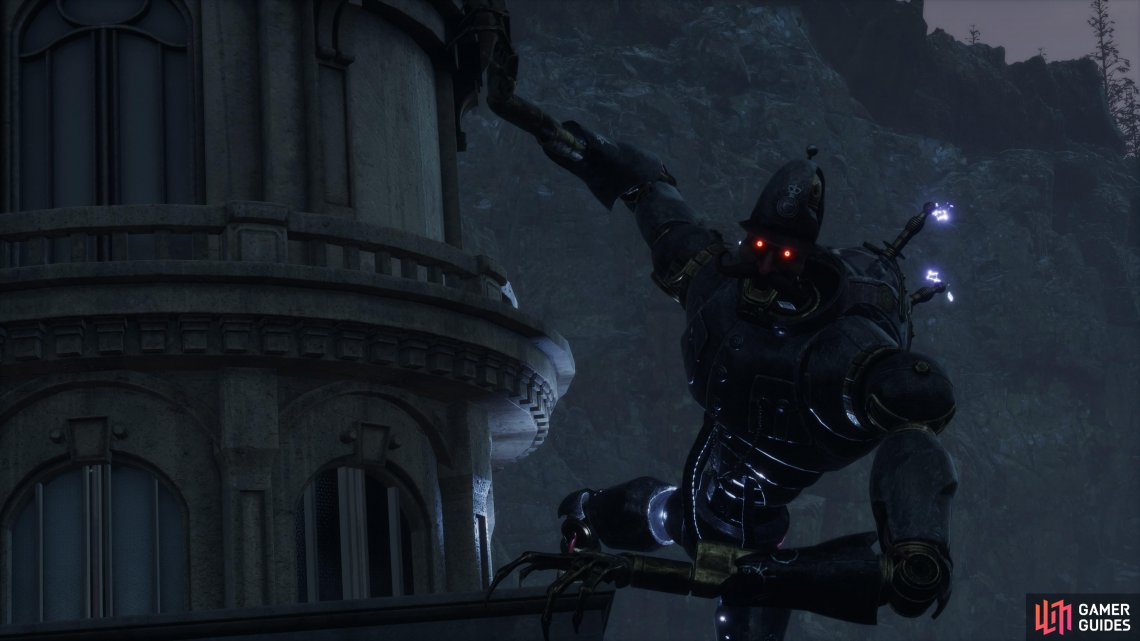
Pros
- Finely polished gameplay and visuals
- Nightmarish enemy designs
- Ruthless but compelling challenge
- Conceptually ambitious "Liar" system
Cons
- Derivative in its core design
- Themes and story underexplored
Aside from perhaps Alice in Wonderland, there may be no children’s fable that is as frequently adapted as Pinocchio. Carlo Collodi’s tale of a mischievous sentient puppet has found itself shaped and reshaped in all manner of media since its initial publishing back in 1883. In the ensuing centuries, The Adventures of Pinocchio has been told and re-told through picture books and stage plays, anime series and operas, and live-action movies and TV specials - perhaps the most notable being Walt Disney’s 1940 feature film, complete with that donkey transformation scene that you’re scared of.
Collodi’s fable - initially conceived as a cautionary tale for naughty children - is able to reinvent itself time and again due to its enduring themes: family, integrity, honor, growth, the moral code and, ultimately, identity. And it is this last aspect that truly stands out in the modern age. While some would argue that Pinocchio is a fairly conservative story - Be good, do as you’re told, follow the straight and narrow path or severe punishment awaits - it is through his mistakes and errors, loves and losses, and lapses of judgment and trust that Pinocchio is able to find his true identity, becoming more than his initial conception, more than his design, and this is the most liberating nature of the text.
These themes of growth, identity, chance, and choice forms the backbone of Lies of P, a video game adaptation of the Pinocchio fable developed by South Korean studios Neowiz and Round 8 Games. Lies of P takes the worlds, characters, and themes of Collodi’s stories and then repackages them as a ruthless “Soulslike”. It’s admittedly a strange marriage of source material and genre, though given the darker elements of the original text (wherein Pinocchio is lynched, has his feet burned off, and kills his cricket companion with a hammer), perhaps the darkest of all gaming’s genres will prove to be a fine fit.
A finer fit than Pauly Shore, at any rate.
Set in the fictional city of Krat, a sort of European amalgamation that fuses the styles of capitals such as Rome, Paris, and Berlin, Lies of P sees a newly created automaton given sentience by a mythic lady with turquoise hair, (Collodi’s original “Blue Fairy”). The puppet (which we’ll call “P” from hereon in) is told that Krat is suffering great tragedy. A terrible disease known as Petrification - the fallout of failed experiments by a party of alchemists - is running rampant through the civilians. Additionally, the automated servants of the city have suddenly run amok, slaying their owners in an incident known as The Puppet Frenzy. In the aftermath of this double catastrophe, Krat has become a city plagued with death and destruction, its once beauteous streets now awash in blood and oil.
Krat’s final hope lies in P, one of the most advanced creations of master scientist Mr. Geppetto, and one of the only puppets to have forgone “The Great Covenant” - a series of rules imprinted on all automatons to prevent ego, dishonesty, and violence. P must now journey through the war-torn streets of Krat, find his missing creator, uncover the truth behind the puppet revolt, and see if any semblance of restoration can return what remains of the city and its people.
And perhaps, en route, the young hero may learn more about themselves, their identity, their purpose, and their own moral compass. Are they an indentured servant to humankind? A self-driven being of flesh and blood? Or perhaps something that exists somewhere inbetween?
The truth could be as plain as the nose on their face.
(1 of 2) P’s journey will take them from the slums and alleyways of Krat
P’s journey will take them from the slums and alleyways of Krat (left), through to its most opulent locations, such as the Estella Opera House. (right)
In Lies of P, players guide the titular avatar as they hack and slash their way through the Gothic locale. Standing between the resourceful puppet and the city’s salvation is an army of rogue automatons - from royal guards to housemaids, train conductors to guard dogs, and pretty little harlequins to terrifying soprano tarantulas. If this weren’t enough, then P will also have to contend with a rash of horrifying mutants that have surfaced on the city limits - wretched creatures of cosmic horror that represent the worst mistakes of the alchemist endeavors.
In face of this mass opposition, P has a variety of creative weaponry up their sleeve, (literally), and will progressively gain access to an increasingly over-the-top range of bladed and blunt force weaponry: daggers, rapiers and lances; electrical buzzsaws, acidic spears, and flaming pickaxes; and gargantuan cleavers of metal and bone. For added firepower, P is also equipped with the pinnacle of modern offense, The Legion Arm. This interchangeable appendage can be equipped with a variety of explosives, booby-traps, projectiles and other tools to give P an added edge in battle.
With this devastating arsenal, a smartly built skill tree, and a variety of effect-laden accessories, (not to mention a wardrobe of 100% Goth-drip), P will sally forth through the slums, stations, museums, theaters, and opera houses of this once majestic city, waging war against a gallery of uniquely skilled and highly hazardous enemies, while clashing steel in some of the most testing and unforgiving boss battles in recent memory.
(1 of 2) Lady Antonia
Lady Antonia (left), and The Black Rabbit Brotherhood are among the individuals for whom honesty may be the best policy (right)
Lies of P wears its design influence boldly and without shame. This is a Soulslike which openly - loudly - ticks every single box that made its FromSoftware brethren so successful. Lies of P owes an incredible debt to Bloodborne in particular, and is similar enough in concept, design, control, pace, flow, and aesthetic as to almost be its sibling. There are few features of the renowned adventure that aren’t replicated wholesale, and it’s frankly impossible not to initially perceive Lies of P as a direct imitator of the games that built the genre’s reputation.
However, while Soulslikes have flooded the market in the wake of FromSoft’s success, many have failed to capture the style, polish, or engaging nature of that studio’s stellar releases. Lies of P, while similar enough as to be template, stands out thanks to its complete commitment to quality at almost every turn. Yes, Lies of P liberally ahem “borrows” almost all of its mechanics, control systems, upgrade patterns, and status effects from these other titles, but these features are delivered with such universal polish and competence that it immediately affords the title a pass on its suspiciously familiar design choices.
By synergizing its core gameplay with already-successful titles, Lies of P is then better able to better focus on forging its own take on Krat and its inhabitants, allowing the dedicated Soulslike fans to dive straight in to mechanical mystery, immediately comfortable with the game’s design and ready-baked for the challenge ahead.
(1 of 2) By acquiring and upgrading weapons, skills, and abilities
By acquiring and upgrading weapons, skills, and abilities (left), P will boost their chances of survival (right)
And what a challenge. Lies of P, as is to be expected, is tough-as-nails. A game in which patience, precision, and smart strategy are key to seeing victory not only against the campaign’s endurance-testing bosses, but even the most standard of enemies found wandering the streets. As the resourceful young puppet battles across Krat, the enemies only become smarter, deadlier, and better testing of the player’s abilities. Death is an inevitability here, and it is through experience, concentration, and smart appropriation of weaponry and gear will P gain the upper hand. There are no alternate difficulty options. The player must work with the tools, weapons, and companions at hand to win the day.
There will be moments where P - many, many hours into the adventure - will be felled by a half-broken, broom-wielding housemaid. There will be times when a boss will defeat P with only “one more hit” of health remaining. But while these moments can be infuriating, the rich, deep combat and desire to push through to the next locale encourages the player to pick themselves up, dust themselves down, and return to the breach.
As much as Lies of P is unforgiving, it’s compelling. And it’s this compulsive element that keeps the player returning in the face of repetitive defeat. P’s journey is punctuated with engaging showdowns and curious characters: A grotesque monster mash in a ruined cathedral, an exhilarating brawl with a family of vigilantes, a slobberknocker with a half-man, half-machine wrestler, and a swashbuckling battle at an amphitheater are among the adventure’s many highlights, and the thirst for further instances such as these fuels the fire to press on.
As much as Lies of P is unforgiving, it’s compelling. And it’s this compulsive element that keeps the player returning in the face of defeat.
The spine of Lies of P’s storytelling is formed by the protagonist and their choices and actions. As P battles through Krat, they will encounter individuals of honest and dubious character - though rarely are their intentions clear from the outset. By interacting with these locals - accepting or refusing their help, performing sidequests, offering trinkets, or even just engaging in conversation - P will sew themselves in the fabric of humanity.
Lying, as the title suggests, forms part of these interactions, and the player will often be faced with the choice of being dishonest in order to push forward. Sometimes, a white lie may prevent a character’s heart from breaking, (it could even keep a heart beating), but cold truth, harsh as it may be, can also open important paths. In Lies of P, the balance of truth and dishonesty shapes the fate of P and the people around them.
In addition to their fib-heavy nature, P can also develop their identity through other actions. These include the solving of riddles, the deciphering of cryptids and puzzles, the learning of, (and effective usage of) emotes such as dancing, bowing, and taunting, and also through culturous activities such as reading and listening to music. While we would assume that the goal of this endeavor is to see P reach humanity, perhaps the individual player may find that being A Real Boy isn’t all it’s cracked up to be. More human than human? Perhaps.
The lying/humanity system in Lies of P is admittedly, more ambitious in its concepts than is delivered in its execution. The mechanic doesn’t quite hit its lofty goals, but is nonetheless intriguing and unique. It can open (and close) doors, leading to curious outcomes for P and their associates. Lies of P’s narrative as a whole is solid, if marred by some predictability and moments of convenience, but the adaptation of the Pinocchio mythos is charmingly handled, with recognizable characters and thematic iconography from the original tales being smartly woven into the game world.
I could give examples, but many of these elements are best discovered first-hand.
Sorry, there’s no sexy goldfish.
(1 of 2) P will lock horns with terrifying enemies of both the mechanic
P will lock horns with terrifying enemies of both the mechanic (left), and organic variety (right)
Ultimately, Lies of P‘s greatest strength is its overall sense of polish. The title boasts some superbly designed characters and well-realized locales, bedecked in a murky aesthetic that is oddly arresting despite its downcast nature. For a (mostly) silent protagonist, P themselves is an intriguing hero, though the lion’s share of the design accolades must go to the enemies tossing harm in the puppet’s direction - particularly the nightmare-inducing bosses. Lies of P also boasts a subtle, cinematic score, that suitably underpins the atmosphere without becoming intrusive. It’s easy to become lost in the atmosphere of Krat, which is surprising given the abject misery on display.
This polish also applies to the title’s technical aspects. Played on PS5 in Performance Mode, Lies of P maintained a rocksteady framerate even in the most chaotic of circumstances, with nary a glitch to be found and only minimal camera-wrestling, (a staple of the genre). It’s also a very substantial adventure, pushing beyond the 40-50 hour mark for the adventurous, (though Soulslike experts may come in under par). Additionally, the branching conversations, huge array of weapons, hidden secrets, and alternate endings offer replay value for the sadists among you. So, I expect a No Hit playthrough by the holidays.
In a year of fantastic releases, Lies of P stands alongside the season’s finest offerings.
These deliberately paced and notoriously unforgiving RPGs are not for everybody, and Lies of P is no exception. But for those players who live for the frame-perfect ripostes, merciless enemies, overkill armaments, and the bleak, somber tone of gaming’s most savage genre, this finely crafted reimagining of a childhood classic absolutely delivers. What it lacks in originality, it makes up for in smart design and weighty action, ultimately evolving beyond its initial copycat appearance to become a rock solid example in its own right. In a year of fantastic releases, Lies of P stands alongside the season’s finest offerings. No strings attached.
Ruthlessly Compelling
With polished gameplay, a splendid aesthetic, and a demonstrable commitment to quality, Lies of P evolves beyond its over-familiar designs to become a splendid new entry in the genre that mercy forgot. For players who believe staying down is never an option, this engaging new Soulslike will absolutely deliver the action, adventure, and challenge you seek.
Gameplay:
Sound:
Graphics:
Story:
Value Rating:























 Sign up
Sign up
No Comments